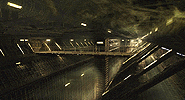
How

How
Director Jean-Pierre Jeneut's first foray into Hollywood filmmaking was this, the fourth ALIEN movie. He brought with him a core group of talented colleagues with whom he worked in the past, including visual effects supervisor and friend Pitof, and first unit director of photography Darius Khondji. The trio had collaborated on Jenuet's previous film, THE CITY OF LOST CHILDREN, a visually stunning fantasy with some of the most remarkable visual effects produced outside of the United States.
Pitof enlisted the compositing and matte painting prowess of his Parisian effects house, Duboi, to provide over 150 composites to ALIEN RESURRECTION, including
Visual effects coordinator Kerry Shea remembers the inherent challenges involved with such a setup: "Duboi essentially relocated here to L.A. from their home in Paris to work on the film. They brought about 20 artists, all their equipment, as well as a Solitare film recorder--they did all their own filmouts on the movie--and they completely relocated their staff, at great expense to the company. That was their level of commitment to the film."
With Pitof's broken English, and Jenuet's education of English while directing on set, language barriers were tackled both on first unit shooting as well as visual effects duties. Shea said, "It was really tough for Duboi's artists, because the majority of them are very young, like in their 20s, they're all Parisian, and for many of them, it was their first time in the United States. Not only did they have the pressure to complete the high quality effects shots for ALIEN, but also deal with the significant culture shock."
Henry elaborated on this point, "The director was a stranger in a strange land, which led to the involvement of his old friend Pitof, someone from his past that he could rely on. Pitof and I really got along really well. It pretty much worked out that he would oversee all of the Duboi effects shots, while I supervised the underwater sequences, as well as VIFX's shots and the miniature shoot."
One of the major portions of the visual effects pie was the elaborate miniature setups to be showcased throughout the film. Supervising the construction of the models were Ian Hunter and Matthew Gratzner of Hunter-Gratzner Industries. Hunter told me, "We got involved while the designs of the ships were still being conceived, so we were able to get involved with their designs, along with production designer Nigel Phelps."
An early design of the Auriga, the film's science ship, was vertically oriented--a cruciform shaped ship with many curves and rounded edges. "That design was ultimately scrapped," Gratnzer said, "since we were shooting in 2.35 widescreen, the ship would always appear very small in frame. We ultimately went with a wide ship design." Rather than looking back at previous ALIEN films for design inspiration, they were more interested in advancing on Jenuet's original vision for the new film. Gratzner said, "The Auriga took a lot of design cues from turn of the century blast furnaces, sort of a gothic design, with a lot of industrial pipe work."
Gratner continued: "I would go down to the set just about every other day and would take pictures of the live action set designed by Nigel Phelps. The film's art department was very open to our suggesstions when it came to designs. Sometimes they'd give us a sketch, or a foam mockup, or just a rough idea of what they wanted, and we'd come back with some models and blueprints, and then it would either be approved or altered. It was never the case where they handed us a set of blueprints and said, 'here, make this.'"
compositing of miniature photography, matte paintings, set extensions, and 2D and 3D animation. Working with Pitof was visual effects supervisor Erik Henry, whose effects past includes TALL TALE, BATMAN RETURNS and the HOT SHOTS films. Henry told me, "I knew producer Bill Badalato from the HOT SHOTS movies, so I was quite thrilled when he asked me to work on the next ALIEN movie. I am such a huge fan of the series. I think the first time I was truly scared while sitting in a movie theatre was while watching the original ALIEN. I'll never forget it."

One of Duboi's 150 effects shots for ALIEN RESURRECTION, a detailed matte painting of an Auriga corridor.


. . VFX HQ Produced by Todd Vaziri . . http://www.vfxhq.com . . e-mail: tvaziri@gmail.com . .
All text Copyright © 1998 Todd Vaziri, unless otherwise noted